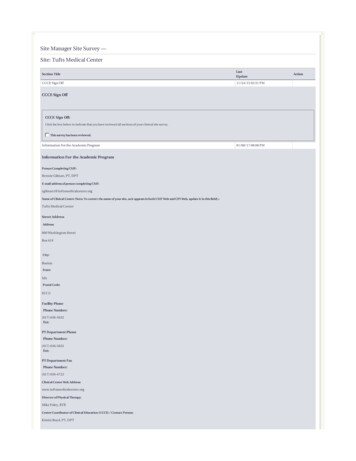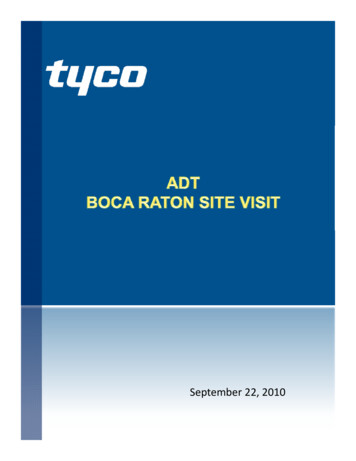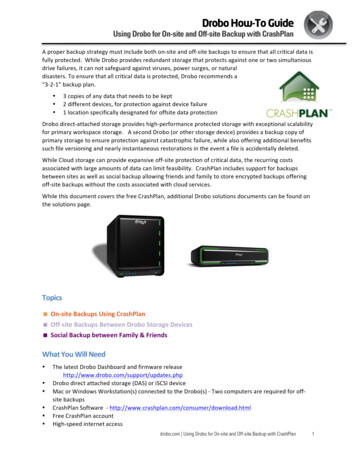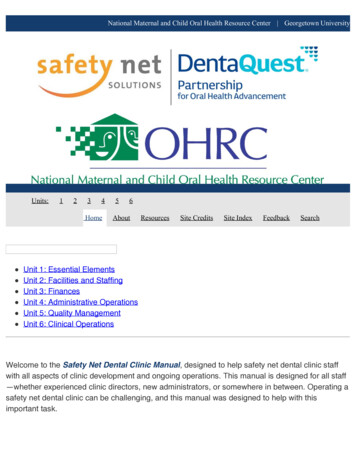
Transcription
The Nunavut Impact Review Board’s 2009 Site Visit Reportfor the Meadowbank Gold ProjectProponent:Agnico-Eagle Meadowbank555 Burrard Street, Suite 375Box 209, Two Bentall CentreVancouver, British Columbia V7X 1M8Monitoring Officer:Contact phone:Amanda Hanson(867) 983-4615Site:Meadowbank site facilities; all-weather access road; Baker Lake fuel tankfarm, storage and marshalling areaProponent Contact:Title:Contact phone:Stéphane RobertEnvironment Superintendent(819) 763-0229Visit dates:August 31 – September 1, 2009Photos:Amanda Hanson, Nunavut Impact Review Board (August 31 –September 1, 2009)1. IntroductionIn December 2006, the Nunavut Impact Review Board (NIRB) issued a Project Certificate (No.004) for the Meadowbank Gold Project (Project) in accordance with Section 12.5.2, NunavutLand Claims Agreement (NLCA).The project includes a gold mining operation located approximately 70 kilometres (km) north ofthe Hamlet of Baker Lake, as well as ancillary infrastructure consisting of barge unloadingfacilities, a laydown storage and marshalling area, a 40 million litre (ML) fuel tank farm, andassociated interconnecting roads located approximately 2 km east of Baker Lake. Theconstruction of a 110 km all weather private access road (access road) from the Hamlet of BakerLake to the Meadowbank mine site was completed in 2008. The access road opened to minerelated transportation of materials and personnel in March 2008.NIRB 2009 Site Visit ReportMeadowbank Gold Project1
Supplies are shipped via barge from southern origins to Baker Lake where they are offloaded atthe laydown and marshalling facilities. From there, materials and fuel are transported to the sitevia truck haul along the 110 km access road.At the time of the site visit, no mining activities had yet commenced. Construction of theMeadowbank site and exploration drilling are ongoing, with Agnico-Eagle Mines Ltd (AEM)hoping to begin pre-commissioning of the mine equipment by early 2010.2. Objectives & Focus of Site VisitAs per the Project Certificate (No. 004) issued for the Meadowbank Gold Project, the NIRB isresponsible for the monitoring of this Project in accordance with Articles 12.7.1 and 12.7.2 of theNLCA.The objectives of the NIRB’s site visit were therefore to determine whether and to what extent theland or resource use in question is being carried out within the predetermined terms andconditions (Section 12.7.2 (b), NLCA).Prior to the site visit, the Monitoring Officer reviewed the following items: Final EnvironmentalImpact Statement, Final Hearing Report, Project Certificate (No. 004), follow up correspondencefrom the 2008 site visit (attached as Appendix A), Terrestrial Ecosystem Management Plan;Transportation Management Plan for the Tehek Lake All Weather Private Access Road;; andAEM’s 2008 Meadowbank Annual Report. Based on this review, the 2009 site visit focused uponthe following parameters:1.2.3.4.5.6.7.8.9.General ObservationsWater Quality and Waste Management (Conditions 25 and 27)All-Weather Private Access Road (Condition 32)Marine Environment (Conditions 36 and 38)Wildlife and Terrestrial (Conditions 56, 58, and 59)Noise (Condition 62)Human Health (Condition 66)Air Quality (Condition 71)Other (Condition 81)The observations resulting from this site visit shall, wherever possible, be incorporated into themeasurement of the relevant effects of the project, as per Section 12.7.2(a) of the NLCA.3. 2009 Site VisitOn Monday August 31, 2009 the NIRB staff joined Agnico-Eagle representative Stéphane Robertto tour the ancillary facilities in Baker Lake. The tour included the fuel storage area and bargeoffloading facilities.On the morning of September 1, 2009, Stéphane Robert of AEM and NIRB staff Amanda Hansonand Kelli Gillard met in Baker Lake and travelled via the access road to the Meadowbank site.The site visit included a tour of facilities at the Meadowbank site which comprised: the camp;mill; Goose Bay Dike (north portion); active mine area; air strip; fuel storage area; waste andhazardous materials storage area; and incinerator.NIRB 2009 Site Visit ReportMeadowbank Gold Project2
The following observations were made during the site visit:3.1. General ObservationsThe following are general observations made during the site visit and do not pertainspecifically to any particular terms or conditions of the Project Certificate:a. A meeting with François Landry of AEM at the barge landing and marshalling facility inBaker Lake provided discussion regarding an all-terrain vehicle (ATV) trail along theshoreline of Baker Lake that has been impacted by the presence of AEM’s spud barge,fuel transfer pipeline, and barge off-loading equipment (impact initially identified duringthe Monitoring Officer’s 2007 site visit). AEM has since created an area specifically forATV crossing that does not interfere with any fuel transfer or barge off-loading activities(Photo 1).b. During the drive from the Hamlet of Baker Lake to the Meadowbank site, a number ofcaribou herds were viewed alongside the access road, ranging in size from a group of fourindividuals to one of approximately forty. During the visit the Monitoring Officer did notobserve the recording or relay of this information to dispatch or to the environmentaltechnician on site as required by the Proponent’s management plans (TerrestrialEcosystem Management Plan (TEMP) p 4-16).c. During the drive from the Meadowbank site to the Hamlet of Baker Lake, the touringparty observed a grizzly bear and cub walking away from the all-weather access road(Photo 2). Stéphane Robert advised the Monitoring Officer that he would record thesighting and advise appropriate parties.d. Black triangular flags had been installed approximately every 10 metres along the accessroad, meant to increase visibility – especially during the winter months.e. Stéphane Robert advised that the communications tower installed at the emergencyshelter at kilometer 37 along the access road had been outfitted with red lighting at therequest of local hunters (Photo 3).f.The Proponent advised that Quarry 22 is serving as a land farm for contaminated soilsand as a storage site for used tires.g. On route to the Meadowbank Site, the Monitoring Officer visited Nuna M&T’spreviously permitted “Nova Camp” located approximately 3.5 km north of the Hamlet ofBaker Lake. Stéphane Robert advised that no further activities were conducted out of thiscamp, but that AEM was storing fuel at the Nova Camp (Photos 4 and 5).h. TheMeadowbank site employs a dual chamber forced air incinerator for the combustionof all non-hazardous, combustible materials at the site (Photo 6).NIRB 2009 Site Visit ReportMeadowbank Gold Project3
Photo 1: ATV crossing at Baker Lake fuel storage and barge landing facility.Photo 2: Grizzly bear and cub walking northwest, away from the access road.NIRB 2009 Site Visit ReportMeadowbank Gold Project4
Photo 3: Communications tower at kilometre 37.Photo 4: Fuel storage at Nova Camp.NIRB 2009 Site Visit ReportMeadowbank Gold Project5
Photo 5: Fuel storage at Nova Camp.Photo 6: Dual chamber forced air incinerator.Sections 3.2 through 3.8 relate to those sections of the Meadowbank Project Certificate asindicated, with specific terms and conditions providing a basis for the observations.3.2. Water Quality and Waste Managementa. Condition 25NIRB 2009 Site Visit ReportMeadowbank Gold Project6
“Cumberland shall manage and control waste in a manner that reduces oreliminates the attraction to carnivores and/or raptors. Cumberland shallemploy legal deterrents to carnivores and/or raptors at all landfill and wastestorage areas ”During the 2008 site visit, all domestic and combustible wastes at the Meadowbanksite were separated and stored in sea-cans prior to incineration.GN-DoEConservation Officer Joel Rose stated that keeping wastes inaccessible to wildlife isan acceptable and legal deterrent to carnivores and raptors.During the 2009 site visit, all domestic, hazardous, and combustible wastes wereobserved to be segregated and stored in sea-cans prior to incineration or shipment toapproved disposal facilities (Photos 7 and 8).No carnivores or raptors were sighted near the mine site camp or other facilitiesduring the 2009 site visit.Photo 7: Kitchen waste segregated and secured.NIRB 2009 Site Visit ReportMeadowbank Gold Project7
Photo 8: Waste segregation and storage area.b. Condition 27“Cumberland shall ensure that the areas used to store fuel or hazardousmaterials are contained using safe, environmentally protective methods basedon practical, best engineering practices.”As evidenced by the 2009 site visit, AEM appears to be storing all fuel andhazardous materials associated with the Meadowbank project in a safe andenvironmentally protective manner (i.e.secondary containment of fuel storage areas,secure containment of hazardous materials) (Photo 9).NIRB 2009 Site Visit ReportMeadowbank Gold Project8
Photo 9: Baker Lake fuel tank farm.3.3.All Weather Private Access Road (AWPAR)a. Amended Condition 32“AEM shall operate the all-weather road as a private access road, andimplement all such measures necessary to limit non-mine use of the road toauthorized, safe and controlled use by all-terrain vehicles for the purpose ofcarrying out traditional Inuit activities. The measures AEM shall undertakeinclude, but are not limited to:a. Maintaining a gate and manned gatehouse at kilometer 5 of thePrivate Access Road;b. In consultation with the Hamlet of Baker Lake, the local HTO, andthe KivIA, update the All-Weather Private Access Road ManagementPlan to set out the criteria and processes to authorize and ensuresafe and controlled non-mine use of the road by all-terrain vehiclesfor the purpse of carrying out traditional Inuit activities, andmeasure to limit all other non-mine use of the road. The updatedNIRB 2009 Site Visit ReportMeadowbank Gold Project9
c.d.e.f.g.h.Plan is to be submitted to the GN, INAC, and KivIA for approval nolater than one (1) month after the approval of revised Condition 32;The posting of signs in English and Inuktitut at the gate, each majorbridge crossing, and each 10 kilometres of road, stating thatunauthorized public use of the road is prohibited;The posting of signs in English and Inuktitut along the road route toidentify when entering or leaving crown land;Prior to opening of the road, and annually thereafter, advertise andhold at least one community meeting in the Hamlet of Baker Lake toexplain to the community that the road is a private road with nonmine use of the road limited to approved, safe and controlled use byall-terrain vehicle for the purpose of carrying out traditional Inuitactivities;Place notices at least quarterly on the radio and television to explainto the community that the road is a private road with non-mine use ofthe road limited to authorized, safe and controlled use by all-terrainvehicles for the purpose of carrying out traditional Inuit activities;Record all authorized non-mine use of the road, and require all minepersonnel using the road to monitor and report unauthorized nonmine use of the road, and collect and report this data to NIRB one(1) year after the road is opened and annually thereafter; andReport all accidents or other safety incidents on the road, to the GN,KivIA, and the Hamlet immediately and to NIRB annually.”The Proponent has installed and is maintaining, a gate and manned gatehouse atkilometer 5 of the access road (Photo 10). The gatehouse is manned while the roadis in operation for mine related traffic, with the gate in a lowered position and alltraffic (both north and south bound) being required to check in with the employee atthe gatehouse before proceeding.The required signage was posted following the Monitoring Officer’s 2008 site visit,and is currently in good condition.NIRB 2009 Site Visit ReportMeadowbank Gold Project10
Photo 10: Gate and gatehouse looking south toward Baker Lake.3.4.Marine Environmenta. Condition 36“Cumberland shall ensure the placement of local area marine mammal monitorsonboard all vessels transporting fuel or materials for the Project throughChesterfield Inlet.”During the site visit, CB radio traffic indicated that marine mammal monitors fromChesterfield Inlet had arrived in Baker Lake and were awaiting turnaround onanother vessel back to Chesterfield Inlet.3.5. Wildlife and Terrestriala. Condition 56“Cumberland shall plan, construct, and operate the mine in such a way thatcaribou migration paths through the Project, including the narrows west ofHelicopter Island are protected. Maps of caribou migration corridors shall bedeveloped in consultation with Elders and local HTOs, including ChesterfieldInlet and placed in site offices and upgraded as new information on corridorsbecomes available. Information on caribou migration corridors shall bereported to the GN, KivIA and NIRB’s Monitoring Officer annually.”The Monitoring Officer noted that the required maps outlining caribou migrationcorridors were posted in the site office of the Environmental Superintendent andother employees.3.6.Human Healtha. Condition 66NIRB 2009 Site Visit ReportMeadowbank Gold Project11
“Cumberland shall establish a nursing station and hire a registered on-sitenurse.”Stéphane Robert provided verbal indication that a nursing station had beenestablished on site, and that AEM was employing a full time medic to staff thestation, rather than a registered nurse.3.7.Air Qualitya. Condition 71“Cumberland shall, in consultation with EC, install and fund an atmosphericmonitoring station to focus on particulates of concern generated at the minesite. The results of air-quality monitoring are to be reported annually toNIRB.”At the time of the site visit, the atmospheric monitoring station had not yet been setup. Stéphane Robert indicated that the station would be installed followingdiscussions with EC regarding an optimal location.3.8.Otherb. Condition 81“Beginning with mobilization, and for the
01.09.2009 · NIRB 2009 Site Visit Report 9 Meadowbank Gold Project . Plan is to be submitted to the GN, INAC, and KivIA for approval no later than one (1) month after the approval of revised Condition 32; c. The posting of signs in English and Inuktitut at the gate, each major bridge crossing, and each 10 kilometres of road, stating that unauthorized public use of the road is prohibited; d. The posting of .











